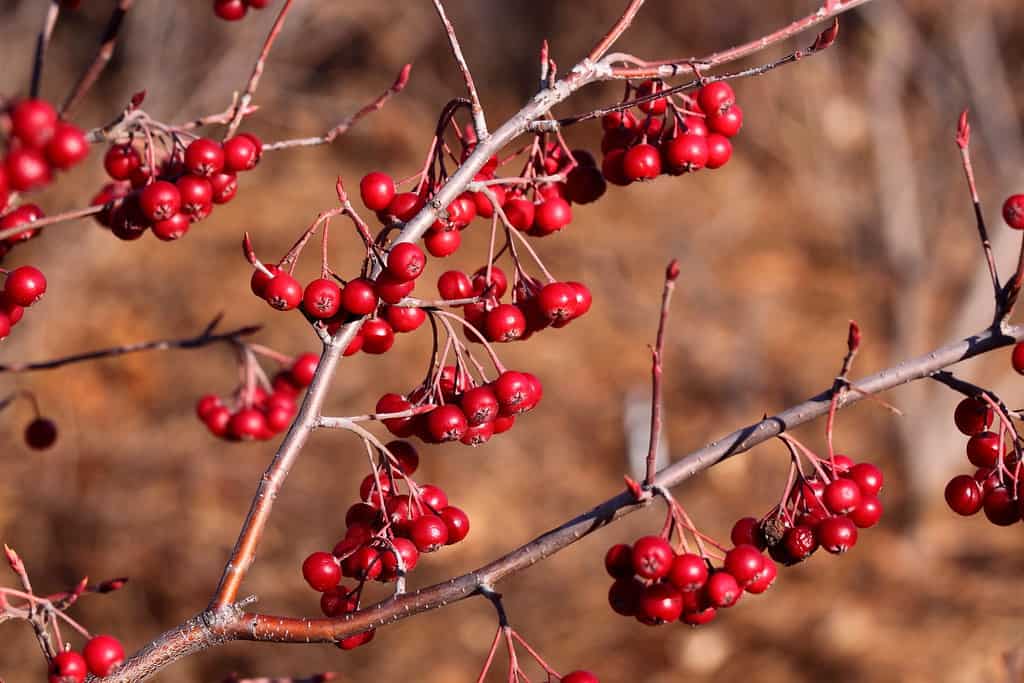
When I first started attracting bluebirds to my yard, I thought they only ate insects. It turns out, fruit makes up a large part of a bluebird’s diet as well, and fruit-bearing plants attract bluebirds.
So, I did some research to find out which plants are best for attracting bluebirds. In this article, I’ll show you seven plants that attract bluebirds, focusing on plants that you can easily grow at home.
Here are seven common plants that attract bluebirds: red raspberry, highbush blueberry, highbush cranberry, northern bayberry, red chokeberry, American elderberry, and Virginia creeper. Bluebirds love to eat the fruits that these plants produce, especially in the fall and winter when insects are scarce. Adding these plants to your yard’s landscape will provide an attractive food source for bluebirds.
Photo above Mr.TinDC is licensed under CC BY-ND 2.0
In this article I’ll tell you more about these seven plants, and I’ll also warn you about three invasive plants that you should avoid planting to attract bluebirds.
Let’s start with a plant that is great for attracting bluebirds in the late summer and fall – raspberries!
#1. Red Raspberry

The red raspberry bush, the same plant that grows the juicy raspberries you get from the store, is really attractive to bluebirds. Bluebirds love raspberries, and will pick them directly off the plant, in the late summer.
Adding raspberry plants to your yard will not only provide you and your family with delicious fruit in the late summer, but it will make your yard extra appealing to bluebirds who will enjoy the late summer fruit as well.
If you’re looking to add this plant to your yard, make sure you choose the “American raspberry” species (Rubus strigosus). You should be able to find it easily at your local garden center or nursery.
The next plant on the list is another common fruit: the blueberry.
#2. Highbush Blueberry
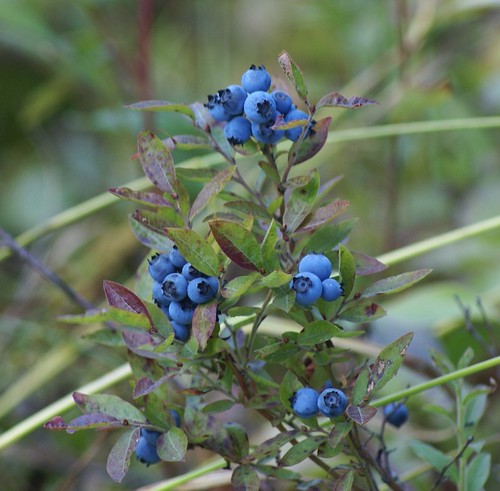
The highbush blueberry plant, which produces the common blueberry, is another plant that bluebirds are attracted to. Plump, juicy blueberries are exactly what bluebirds are looking for, especially in the late summer and early fall when they start adding more fruit to their diet.
If you add these plants to your yard, you’ll have the additional benefit of getting to harvest some blueberries for yourself!
Try adding a row of highbush blueberry plants to your yard to provide an additional, attractive food source for bluebirds.
#3. Highbush Cranberry

The next on the list of plants that attract bluebirds is the highbush cranberry. The highbush cranberry plant produces tight clusters of small red berries that bluebirds adore. See the photo above for an image of highbush cranberries.
Although they are called by the same name, the small red fruits from the highbush cranberry plant (Viburnum opulus) are different from the larger cranberries you might see around Thanksgiving or Christmas in the grocery store. The cranberries you see around the holidays usually come from the American cranberry plant (Vaccinium macrocarpon). See the photo below for standard American cranberries.

Photo by beautifulcataya is licensed under CC BY-NC-ND 2.0
Since bluebirds are so attracted to their fruit, highland cranberries are a great landscaping choice if you’re looking to attract bluebirds to your yard. Check for available highbush cranberry shrubs or seeds in your local garden center or nursery.
Next on the list of plants that attract bluebirds is a less common one – the northern bayberry.
#4. Northern Bayberry

The northern bayberry shrub is a fruit-bearing plant, common along the eastern coast of the US, that produces a berry that is very attractive to bluebirds. If you live along the east coast, this could be a great plant to add to your landscape to attract bluebirds.
Physically, the bayberry plant (Myrica pensylvanica) is a small shrub with dark green, semi-evergreen, leather-like leaves (source). The shrub grows waxy, blue-gray berries which are what makes this plant so attractive to bluebirds and other songbirds.
If you want to add northern bayberries to your yard, you can read more about them on this article from the Morton Arboretum.
#5. Red Chokeberry
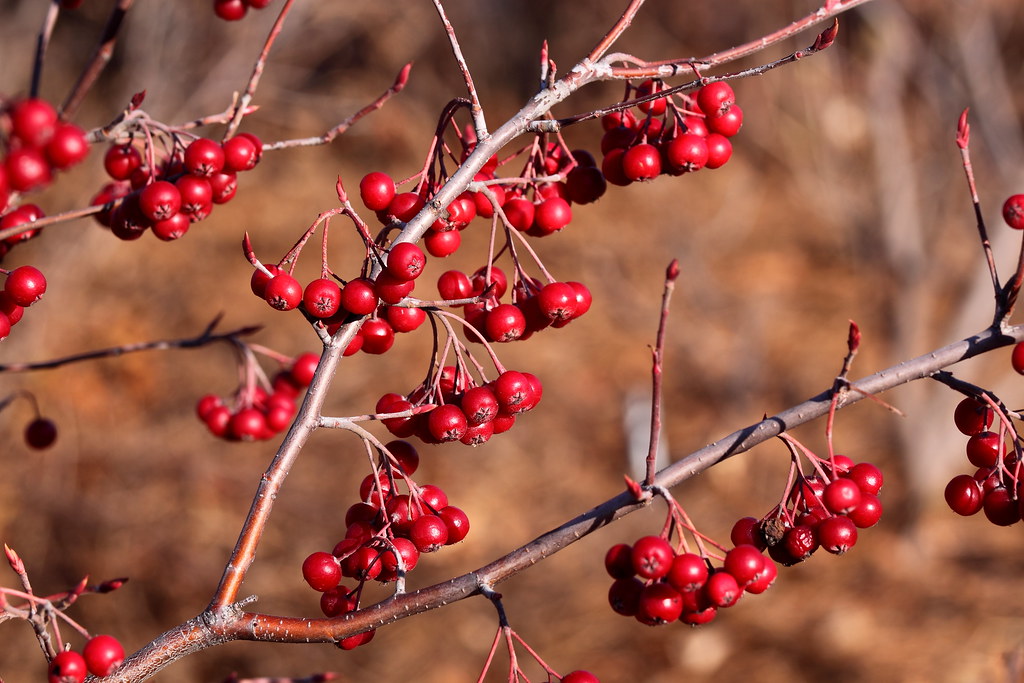
Next on my list of bluebird-attracting plants is the red chokeberry. The red chokeberry plant (Aronia arbutifolia) produces plenty of small, red, glossy berries that bluebirds love to eat in the fall and winter.
If you haven’t caught on to the pattern yet, bluebirds love berries, especially in the winter! These red chokeberries are exactly what bluebirds seek out when the weather gets colder and insects become scarce.
The great thing about red chokeberries is that you can grow them in almost every region of the US (source). Consider adding one or more of these plants to your yard to turn it into a winter haven for bluebirds.
Next, we have the American elderberry.
#6. American Elderberry
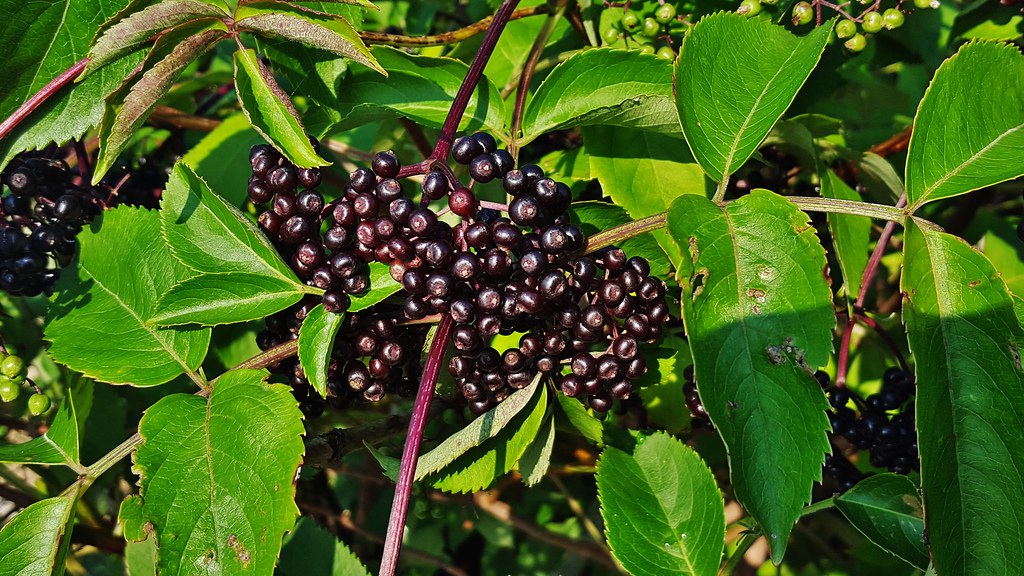
The American elderberry is another one of the many plants that attract bluebirds. Bluebirds particularly love the blue-black berries produced by this plant, and it’s another one that you can easily add to your yard.
This plant goes by a few different names: the American elderberry, common elderberry, black elderberry, or simple “elderberry.” If you are shopping around for this plant, look for its Latin name, Sambucus canadensis, to be sure you’ve got the right one.

Check out the white flowers of the American elderberry plant in the photo above. Your plants will look like this when they are in full bloom.
This plant, like blueberries and raspberries, will produce fruit during the summer months, when insects are still plentiful. So, consider adding it to your yard along some other plants from this list to make sure you have fruit available for bluebirds in multiple seasons.
#7. Virginia Creeper

Virginia creeper, a woody, deciduous, vine, found anywhere from Quebec to Florida, produces a blue-black fruit that bluebirds love to eat. Consider adding this plant to your yard’s landscape as a part of your strategy to attract bluebirds.
The great thing about Virginia creeper is that it can look really cool in your yard. The plant’s green leaves of the summer turn a brilliant red and purple when fall hits.
Plus, since Virginia creeper is a vine, you can train it to climb up a wall, fence, or even the side of your house. Plant it anywhere you want to make it work with your landscaping vision – bluebirds will know how to find it. See how the plant is climbing a wooden telephone pole in the photo below.
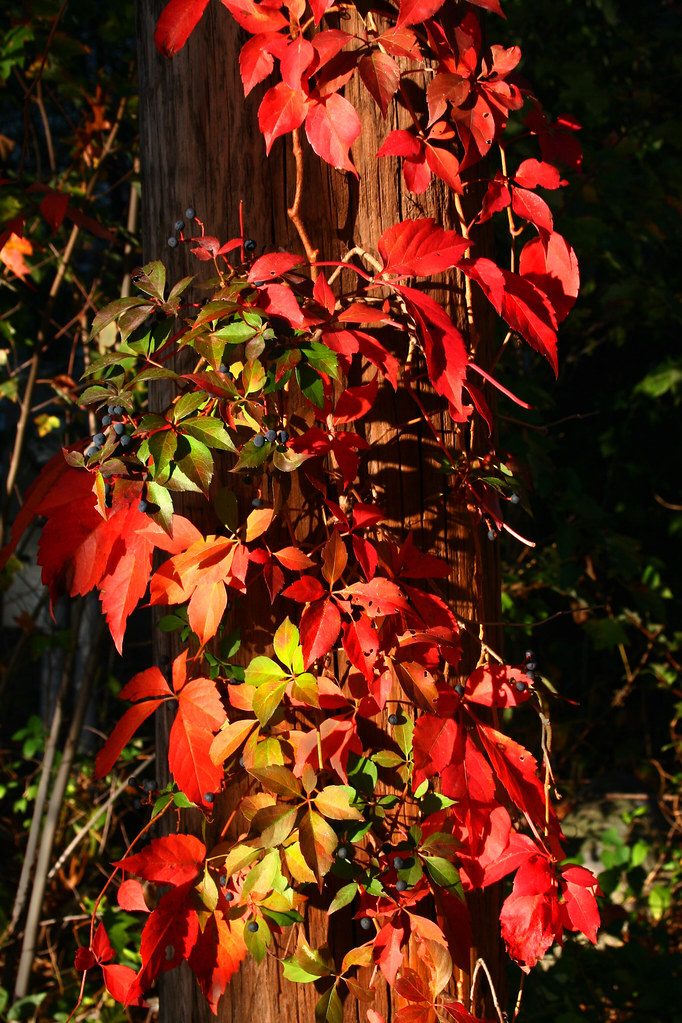
Also, the Virginia creeper plant doesn’t damage building walls like other vines do, so this plant is a great all-around choice for landscaping and bluebirds.
Now, that we’ve talked about seven native plants that attract bluebirds, you should be aware of a few non-native, or invasive plants that you’ll want to avoid.
Invasive plants that you should avoid planting for bluebirds
It might be tempting to plant invasive/non-native plant species in your yard, especially if they are commercially available, aesthetically pleasing, and if bluebirds seem to like them. However, in the long run, cultivating native plants and avoiding invasive species will create a healthier ecosystem in your yard and, ultimately, a better environment in which bluebirds can thrive.
#1. Autumn Olive

Even though bluebirds enjoy the fruit from the Autumn Olive plant, this is an invasive species that you should avoid planting in your yard.
The Autumn Olive plant (Elaeagnus umbellata) was brought to North America from Asia in the 1800s. It was originally cultivated in the US with the intention of avoiding soil erosion (source).
Autumn Olives are particularly harmful to the North American ecosystem due to their ability to displace native plants.
Autumn olive…outcompetes and displaces native plants. It does this by shading them out and by changing the chemistry of the soil around it, a process called allelopathy.
www.Nature.org (source)
Instead of planting Autumn Olive in your yard, consider any of the other berry-producing plants listed above.
#2. Oriental Bittersweet
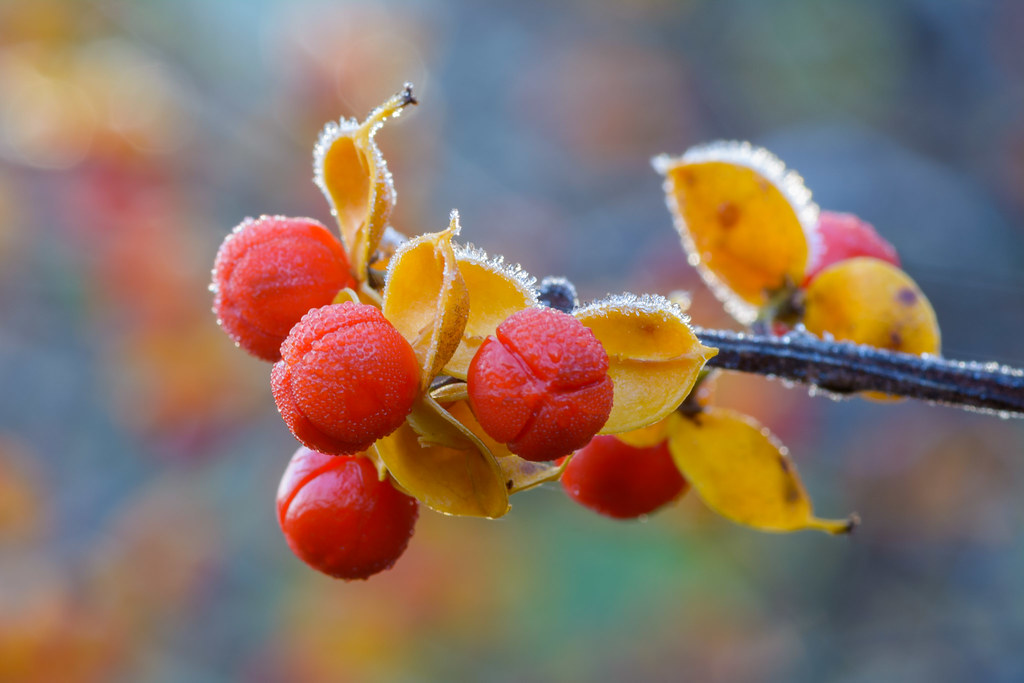
Oriental bittersweet (Celastrus orbiculatus) is another plant that we brought to North America from Asia in the 19th century. Although bluebirds are attracted to the bright red fruits of the Oriental bittersweet plant, this is another invasive species that you should avoid planting in your yard.
The problem with Oriental Bittersweet is that it overruns natural vegetation, strangles native shrubs and trees, and generally “takes over” the area where it is planted. Oriental bittersweet may even be hybridizing with American bittersweet, which could threaten to eliminate the native species altogether (source).
Experts also recommend you avoid planting the American bittersweet plant as well. Many nurseries mislabel Oriental bittersweet as American bittersweet, so it is very difficult to know when you’re getting the right thing. So, at this point it’s just better to choose a different native plant.
Instead of planting Oriental bittersweet in your yard, opt for a native plant like highbush cranberries or red chokeberries, which also produce small red berries that bluebirds love.
#3. Cherry Laurel

The cherry laurel (Prunus laurocerasus), also called English laurel, is an invasive shrub in North America that is originally from Asia and southeastern Europe. Although this is a popular shrub for landscaping, and the fruit of the cherry laurel is attractive to bluebirds, you should avoid planting these shrubs in your yard since they are an invasive species.
The problem with bluebirds eating cherry laurel, and fruit from other invasive plants, is that, after consuming the fruit, they drop the seeds in new areas. This has the potential to further the spread of invasive plants and allow them to “squeeze out” and overtake native plants in these new areas (source).
Instead of planting cherry laurel to attract bluebirds, try a native plant like Inkberry, which is a popular landscaping alternative to charry laurel, and bluebirds love it!
This is not an exhaustive list of invasive plants to North America. When buying plants for your yard, make sure to check with your source, or online, to make sure that the species of plant you are buying is not invasive to your area.
Conclusion
There you have it – a list of seven plants that attract bluebirds (and also three plants to avoid). You could add any of these seven fruit-producing plants to your yard’s landscape in order to make a more attractive and inviting environment for bluebirds.
If you want to attract bluebirds to your own yard, but don’t know where to start, check out my post called “10 Steps to Become a Bluebird Landlord” (click the link here to go to that post). This post will cover everything you need to know as a beginner.

